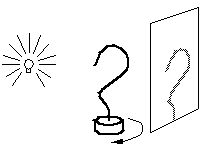
When a circle is displayed on an oscilloscope, and it's width or height are modulated sinusoidally, it produces a strong percept of a circle rotating in depth, although the direction of rotation is unspecified by the stimulus, and thus the percept is apt to reverse its direction of rotation in a bistable manner like a Necker cube.
This phenomenon is not confined to regular geometrical forms, but extends to irregular forms too. For example when an irregular piece of bent wire is rotated in front of a light source, subjects viewing the two-dimensional shadow of the object can perceive its three-dimensional shape as long as it continues to rotate, but perceive only a flat shape when the rotation stops.

Another example known as "biological motion" perception was demonstrated by Johansson [Johansson 1976] who attached small lights at key points on people's bodies, and took movies of them walking about in a dark room, so that only the moving lights were seen.

These phenomena have been deeply mysterious to modelers of visual perception, and have never been explained to any satisfaction by any model.